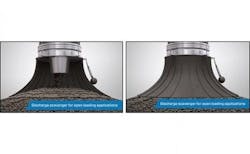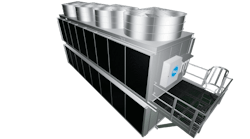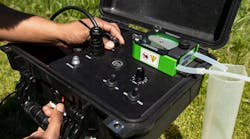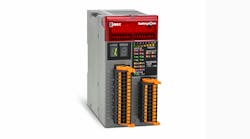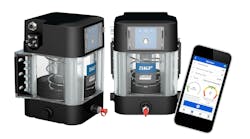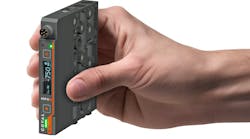Techniques for Dust Management During Loadout
In dry bulk solid material handling operations, workers can be exposed to a plethora of hazards if proper precautionary measures are not taken to create a safe, dust-free environment. Depending on material characteristics, workers are subject to many serious medical conditions of the eyes, nose, throat, skin, respiratory tract, and other vital organs. Common medical conditions include:
- Irritant Contact Dermatitis: A chemical burn to the skin caused by reaction to irritating substances, such as acids, alkaline materials, soaps, detergents, fabric softeners, solvents, or other chemicals.
- Allergic Contact Dermatitis: Similar to ICD, ACD is the presence of irritated skin due to allergic reaction. With ICD, the chemical reaction tends to be widespread in several areas of the body, whereas in ACD, the reaction often occurs only at the point of chemical contact. In both instances, the wound may develop rashes, oozing, drainage, crusted skin, scaly skin, raw skin, thickening skin, lesions, tenderness, blisters, or other physical discomforts. If materials leak to atmosphere, these ailments can effect living things in nearby neighborhoods, schools, hospitals, parks and more.
- Desensitization: When handling harmful chemicals, additives are often used to temporarily reduce the toxicity of handling materials. With repeat exposure, an employee may become desensitized to balancing additives, leaving them susceptible to chemical burns regardless of the additive’s presence. In many cases, this health risk has forced highly skilled employees to change jobs – a situation that could have been delayed or avoided, had better dust control technologies been utilized.
- Silicosis: Inflammation, lesions, and scarring in the upper lobes of the lungs. Side effects include shortness of breath, cough, fever, and cyanosis – a condition which causes blue-colored skin.
In addition to potential health risks, safety hazards are also of great concern when handling dry bulk materials. A primary safety concern is surface dust accumulation, which can cause workplace slips, trips and falls. The most prominent hazard in industry is the threat of dust explosions, which are ignited when suspended dust particles come in contact with a spark or other flammable conductor. Primary dust explosions typically occur inside process equipment and are generally controlled before reaching the external atmosphere. Secondary dust explosions are the result of dust accumulation inside of a building before being ignited by the primary explosion, resulting in a much more dangerous, uncontrolled explosion. In many cases, dust explosions have resulted in totaling plant damage, serious injury, and even death.
Accidents such as these will cause work-related injuries and ailments, which lead to workers’ compensation, short- and long-term disabilities, litigation, fines, and many other expensive repercussions.
Environmental Issues
All dry bulk materials carry unique properties that make bulk loading into open or enclosed vessels a constant challenge for manufacturers worldwide. When calculating potential for dust emissions in bulk loading applications, process engineers are concerned with material characteristics such as bulk density, flow ability, particle size, shape, material friction, hygroscopicity, degradation, saltation point, flow rate, in-vessel material impact, air displacement, and other variables that effect the travel of dry bulk materials. If these calculations are not carefully monitored, loading operations are often executed at volumetric flow rates that are much too high, making for less efficient loading and increased presence of dust.
Health, safety and environmental organisations worldwide are now more strictly enforcing laws against dust emissions because air pollutants can contaminate local waterways and neighborhoods, causing lasting impact to local aquaculture, ecosystems, and more.
Rather than facing these negligent expenses later, precautionary investments can be made in well-designed loading systems to reduce dust emissions.
Vortex Loading Solutions
Per the demands of each application, Vortex Loading Solutions are specifically designed to extract displaced air and control problematic dust mixtures, making them key to dust emission management.
Enclosed Vessel Application
For enclosed loading applications, the Vortex Loading Spout is designed to prevent dust emissions to atmosphere by closing off a vessel’s loading hatch at the scavenger (Figure 1).
In both open and enclosed loading applications, a Compact In-Line Filter System can be installed directly above the Loading Spout to enhance dustless loading by means of a vacuum pull (Figure 2). Throughout the loading process, displaced air and dust are aspirated out of the enclosed vessel via the spout’s filtration system. A reverse pulse jet allows the air-dust mixture to be continuously filtered and reintroduced into material flow. This creates a completely closed loading cycle, which prevents dust emissions and minimizes material loss.
Click here for an animation of this process.
Open Vessel Application
As shown in Figure 3, a detachable loading skirt can be attached at the outlet of a Vortex Loading Spout to assist with dust control in open loading circumstances. By design, a loading skirt rests atop the material pile to retain dust and seal the vacuum pull as materials flow through the spout.
Also pictured, a level-sensing probe can be mounted at the outside of a loading skirt and programmed to automate the spout retraction process. As the material pile grows beneath the skirt, the probe slowly begins to tilt.
Each time the probe is tilted to a 16-deg. angle, an auto-raise feature commands the Loading Spout to gradually retract. When the spout reaches a programmed retraction height, it signals the conveying line to halt material flow. Thus, in open loading applications, the level-sensing probe avoids the overfilling of vessels and eliminates need for visual monitoring during the loading process.
Maintenance-Friendly Filters
The Vortex Compact In-Line Filtration System is designed to enhance maintenance ability and minimize dust build-up on the filters. By incorporating a reverse pulse jet on each filter cartridge, dust build-up is prevented by continuously purging dusts back out of the filters and into material flow throughout each loading cycle. Vortex Compact In-Line Filter Systems also feature easy-access covers at each filter cartridge, allowing for frequent in-line maintenance, inspection or filter replacement without significant disruption to operations (Figure 4).
Self-Sealing Discharge
Although a Spout Filtration System is able to collect the majority of fugitive dust, trace amounts of dust may remain along the spout’s fabric outer sleeve – namely, in the crevasses where the sleeve conjoins with its outer rings.
As a spout extends and retracts, dusts are shaken loose from these areas, causing them to “dribble” through the spout and into atmosphere. To prevent this form of dust emission in enclosed loading applications, a self-sealing discharge (Figure 5) may be installed below the spout scavenger. The self-sealing mechanism automatically opens once the spout is positioned into a loading hatch, and immediately closes once the spout begins to retract.
Installing Vibrators at the Spout Scavenger
When installed along the scavenger of a Loading Spout, vibrators can enhance volumetric flow rate by preventing material bridges and plugs.
Vibrators are also valuable for improving dust management. If vibrators continue to run for a short time (approximately 10-15 seconds) after loadout is complete, the vibrations will encourage fugitive dust remaining in the spout to fall into the vessel.
Spout Construction Options
Vortex Loading Spouts are customizable. Depending on handled material charcteristics, they can be designed to utilize several Zone 20 (internal) & Zone 21 (external) ATEX-certified sleeve and cone construction materials, in order to best equip the spout for durability in its specific application.
How to Select the Proper Loading Equipment
Consult with industry experts to determine the material handling application, then design a spout for purpose to maximize safety, performance, and dust emission management in your unique loading applications.
